https://www.youtube.com/watch?v=BnOw3gMgBOs
10 Ways To Save The Game In Chess

Hey , guys , I was recently playing a game against the lower rated player and I had a position very similar to what you see on the screen right now .
And I played the move queen takes G two .
It's obviously attacking the rook in the corner and my opponent played the move 92 H three .
I captured the rook and the game was basically over at this point , I just won the rook for free and a few moves later , I won the game but had my opponent played the move queen to F three , the game would have went on .
They would have actually saved their rook because the queen defends it and I could take the queen .
But then it's just a queen trade .
Yes , I did still get a pawn out of the deal , but it was just a pawn .
The game was gonna go on and it's a relatively equal position .
White lives to fight another day , but they weren't aware of that trick .
And like I said , just ended up losing .
And after that game , it occurred to me that there are actually a lot of these kind of situations in chess where it looks like something really bad is going to happen .
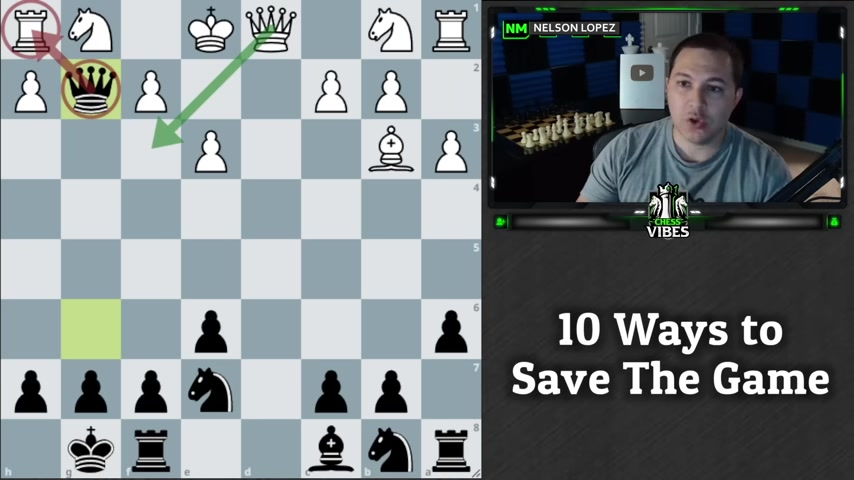
But if you know the secret or the trick to kind of save the position , you can play that and the game goes on , right .
So in this video , I'm gonna give you 10 of these very specific situations where it looks like something bad has happened or something bad is about to happen .
But I'm gonna give you the sort of secret to defend against that and either get into a good position or at least save your position to where you can play on .
So having said that , let's take a look at these 10 different situations .
All right .
So here's the first situation .
You're playing a game and your opponent plays the move queen a five check .
And you're like , oh no , I just got forked .
I'm losing my bishop .
I'm in trouble and you play a move like queen D two and they take your bishop , right ?
Was that the best that you could have done ?
No , absolutely not .
So let's go back .
What should we play in this position ?
Well , Knight to C three actually blocks the check , but at the same time , it defends your bishop and you're totally fine .
The game goes on .
You don't lose a piece , you're just fine .
Right ?
So I want you to remember that a lot of the times on queen to a five check .
If it's for king , your king and bishop .
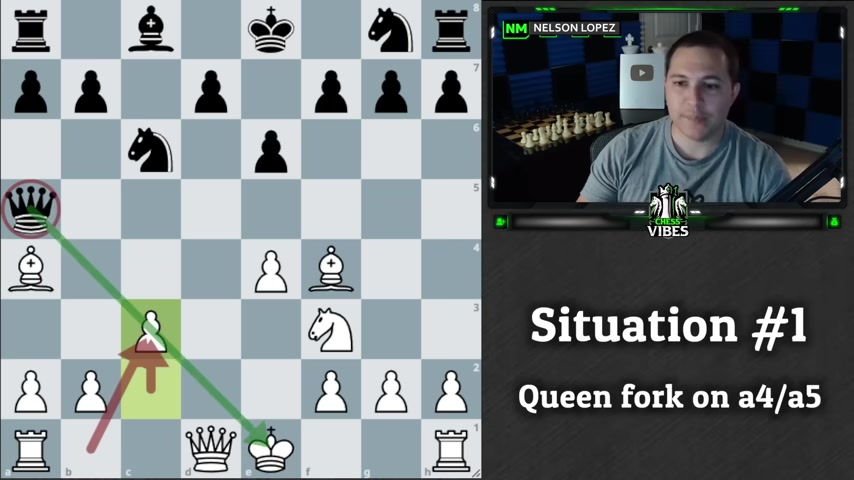
Knight to C three is kind of a natural move that usually you will have available uh to defend your bishop .
Now , a little bonus tip for you .
Here's a position that's very similar , but a little bit different .
And again , black plays queen to a five check and you're like , OK , I know what to do .
Nelson told me this night to see three .
Wait a minute , I don't have a night to move to C three .
I guess .
I'm just losing my bishop right wrong .
In this case , you can play the move C three and we block the check with our pawn .
And we also unleash our queen to defend the bishop on a four , right ?
So this is another version depending on where your bishop is .
If it's on B five or if it's on a four , then your queen can help by just moving the pawn up .
OK ?
So I want you to remember those two options night to C three and C three .
And if you ever find yourself in a fork like this , usually you can save the bishop by doing one of those two things .
All right .
So here's the next situation .
Blacks turn and they play D four attacking your night and you're like , OK , let me move my knight to safety .
Wait a minute .
It's pinned .
I guess I'm just in trouble and I'm losing my night .
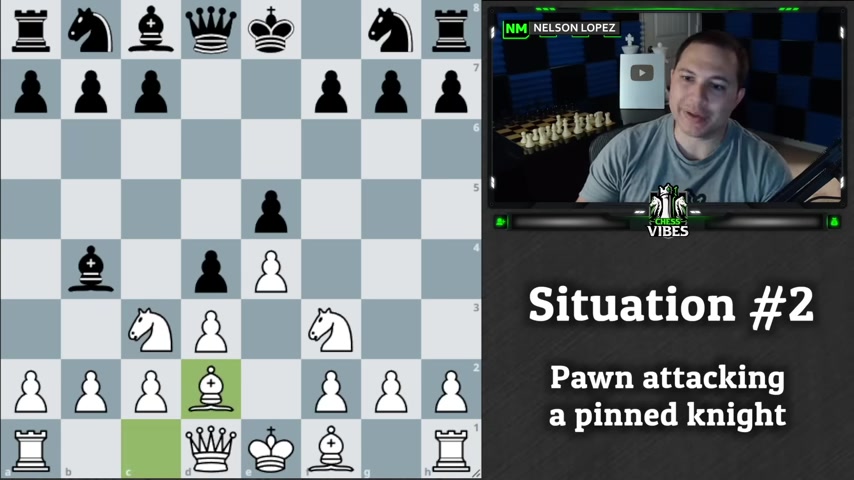
And a lot of people in this position would play something like bishop D two trade and you just lost a night for a , it's a really bad trade and now you're in big trouble .
But what you can do a lot of the times in these situations is attack that bishop with your side .
Pon .
So in this case , it's the aon .
It can also happen over here and you would use the H POD .
But we simply play a three .
And now if black takes their and guess what , we take their bishop and we just trade it .
Of course they can take here , but we just take and we're , we're happy with this , right ?
The other thing that they could try when we attack it , they can retreat the bishop .
Guess what ?
We attack it again .
And now we kind of have the same situation if they take our night , we take their bishop .
It's just a trade and we're happy , right ?
And of course , if they go back , well , now we can move our night somewhere to safety because there's no more pin .
Ok .
So remember if you find yourself in a situation where one of your knights is pinned can happen on either side and your opponent pushes a pawn forward and it looks like you're about to lose a piece .
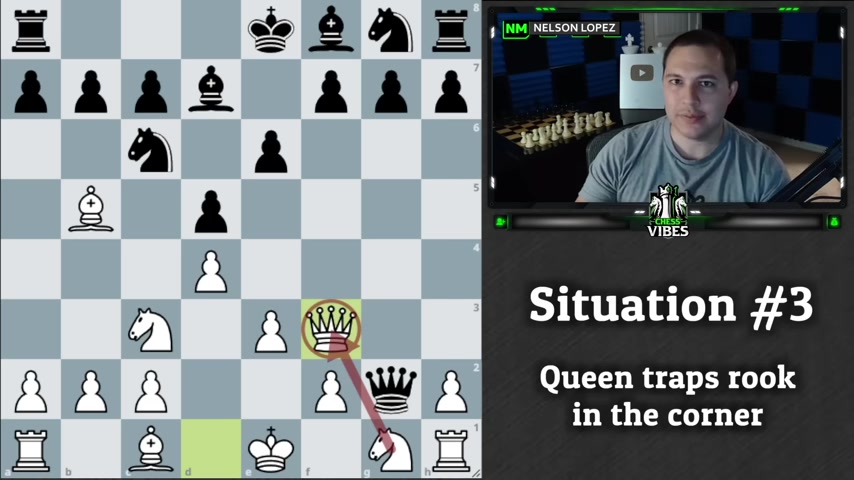
Usually you can save the piece by doing something like this .
Ok .
So keep that in mind pretty common and that's gonna save you .
Uh , you know , more often than , than you realize right .
Here's the next situation and this one should look familiar but black plays queen takes G two and we're like , oh no , our rook is trapped .
I guess we're losing our rook and we have to do something and that's just too bad .
Right .
No wrong .
Remember queen to F three ?
OK .
It's defended by the night .
So you don't have to worry about that .
And this is defending your rook .
So if black tries to take your rook , you're just gonna take their queen , right ?
So a lot of times when your rook is stuck in the corner like this , the only way to defend it is with a diagonal piece .
Usually it's your queen or your bishop like this .
OK ?
And this could also happen if you imagine if your bishop was on E two , you could also play bishop to , to F three to defend your rook that way .
OK ?
So remember this , you don't have , have to lose your rook .
Just play queen F three .
Yes , you still lost the pawn , which is not great , but it's a lot better than losing an entire rook .
All right .
The next situation is very similar .
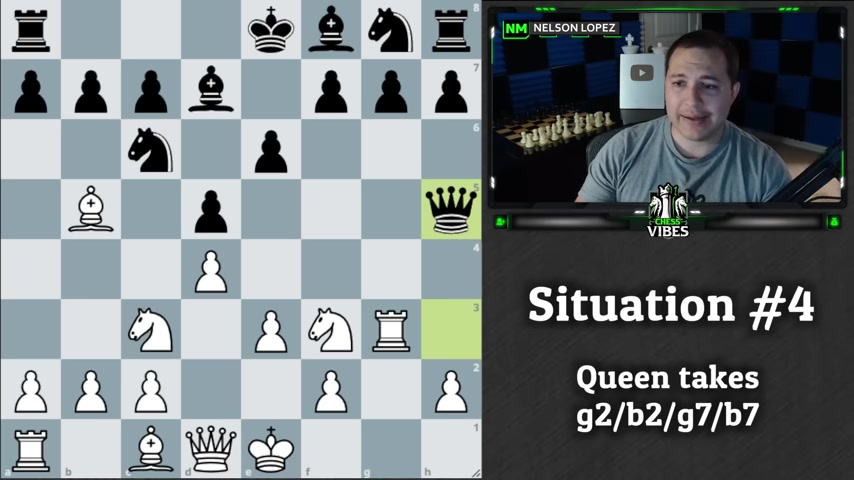
Notice , it's almost the same position except this time our night has already been developed .
So now black takes on G two .
We have to move our rook somewhere , right ?
Because our rook is still being attacked and sometimes people will play to move rook to F one here .
This is really a bad choice .
OK ?
What you want to do if this ever happens is play rook to G one because you gain a tempo on the queen .
You chase the queen around and usually the queen only has one place to go H three .
And sometimes you can even follow that up by getting some more attacks on the queen .
So for example , Rook to G three Jay and the queen around , right ?
And we just got , you know , a rook kind of activated into the game .
Yes , we lost the pawn , which maybe wasn't worth it .
But a lot of times you , you'll be in a decent position if you do this .
OK ?
So remember if the queen ever comes down and takes that pawn , usually you can just slide your rook over .
It can also happen here .
One thing I want to point out , you do have to make sure that your night is defended for this to work .
So right now the queen is defending the knight .
If that's not the case , you might have to try to find another solution .

Otherwise you might just be losing your night .
But in this case , it is defended .
So Rook G one works just fine .
OK ?
So keep that in mind , this is a nice way to get some tempos with your rook on the queen .
And a lot of times that can counteract , you know , counteract the fact that you lost upon .
Sometimes you can even follow it up with knight to G five depending on what you're attacking over here , you might actually have a , some type of a fork , right ?
So , keep all those things in mind .
All right .
So here's the next situation you're playing the game and black plays the move queen to D one check , slams it down on the board and you're like , oh man , I'm in trouble .
I'm getting check mated because if I take the queen , the rook's gonna take me and that's , that's it .
I'm just done for .
So you resigned because you think you , you lost .
Was that the correct choice ?
No , not the correct choice .
Why is that whenever you have this back rank threat like this and you can't take the piece because then the other piece is coming in .
What you can sometimes do is block this check with another piece .

And in this example , our rook over here on E seven can actually just come back and we prevent the checkmate because if the queen tries to take it , guess what this rook is now involved .
And we just actually one black queen if black does that .
So this is an idea that a lot of people forget about .
They forget that if you have some other piece , you can swing it back .
You don't have to just immediately take that piece because then you do lose , right ?
Because if you take it first and now try to come back , it's too late .
It just doesn't have that extra rook defending .
Ok ?
So you have to do it right away before you make any trades because you need this guy to defend it .
And Black's rook now doesn't really play a role .
So you just kind of have your two rooks against Blacks queen and you're OK .
All right .
So that's a good technique to remember to uh defend against the back rank checkmate .
Also a little bonus tip here , be careful when you get to the end of the game like this .
Sometimes it's wise to push one pawn forward to give your king a little escape escape route , right ?
So that if something like this happens , you can normally just run away with your king .
So just keep that in mind .
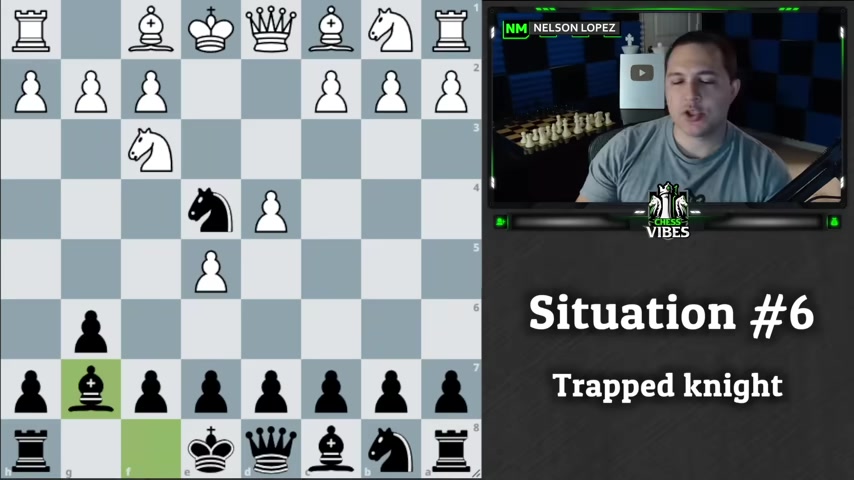
But yeah , this , this rook blocking idea is really good to keep in mind .
All right .
So here's the next situation .
It's white's turn and they play the move queen 22 , attacking our night and we start to look around , ok , let's move our night back .
Wait a minute , wait a minute , everything is covered .
Wait a minute , our nights trapped , we're losing our nights .
We can't go anywhere right wrong .
So if you find yourself in a situation like this where it's being attacked by a queen or another piece , maybe a , a bishop or something , you can play like d five to defend it .
And even though there's on pass to take a pawn , whenever this happens , now , you can recapture with your night and you save your night because that pawn , which was kind of restricting your knight's movement is gone .
Right ?
And so this , you know , just keep that idea in mind .
Sometimes it also works with the other pawns .
So like f five , same kind of a deal if they pass on , you can take .
So depending on the situation , keep that in mind , it's a good way to save a night that maybe , you know , got a little bit overextended and it looks like it's trapped .
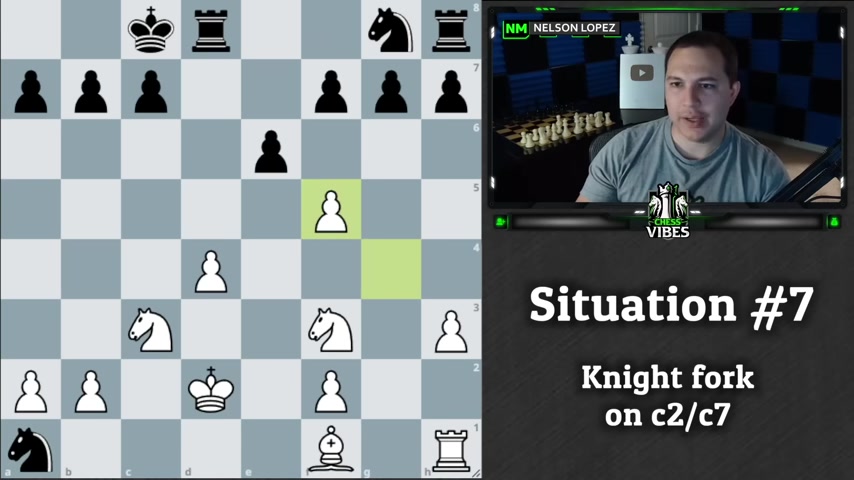
Probably you can do this uh And save it .
All right .
So here's another situation .
It's black to play .
They play the move night to B four .
And let's just say , hypothetically , you didn't see this , OK ?
You were focused on something else .
You played G four to attack the bishop and you didn't see that they could just take this pawn .
So they take it and you're like , great , I'm done for , I'm losing my rook .
I'm just completely lost .
You're thinking about resigning .
You're not sure .
Um What I want to remind you of is a lot of the times when this kind of stuff happens , you can usually get two pieces for your rook .
So how does this , how does this work ?
King to D two ?
OK .
They take your rook , you can take the bishop now , right ?
And let's just say they take you back and what , what do you notice about this night ?
It's trapped , right ?
It can't actually escape .
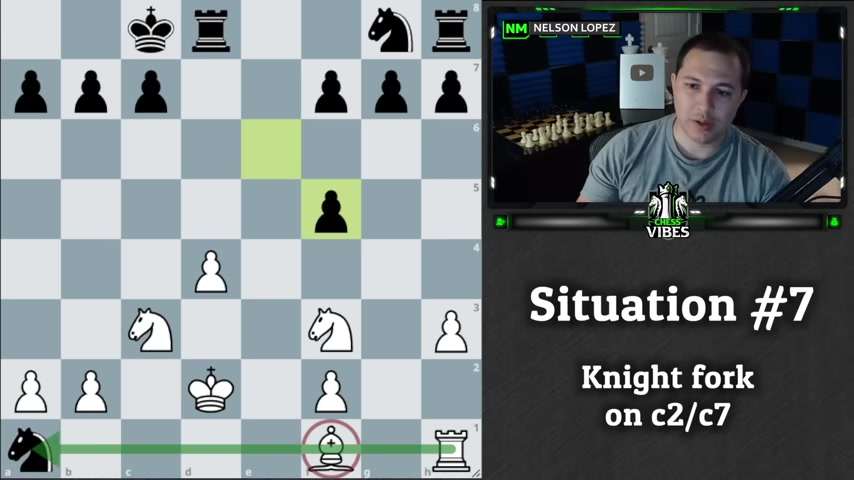
And so what we can do is say , OK , I'm gonna come over here with my king and take it or even just move this bishop and take it with my rook because it's trapped .
And if you can accomplish that .
So let's just say you play bishop D three and black .
I don't know if that's something and you take it , you ended up getting a knight and a bishop or a rook in a pond , right ?
Which is actually not a bad trade at all .
I would say you're in the lead .
Now , I think the two pieces is better than the rook in the pond .
So , what I want you to remember is even if you ever find yourself getting forked by a night like this , you always want to kind of ask yourself , ok , at the end of this fork , can I get that night at least ?
And then maybe if you can get another piece , like in this case , the bishop and you actually come out on top ?
Ok .
So keep that in mind the fact that after the night takes it as long as you kind of plan for that .
That's why we moved king to D two and not like king to E two , right ?
Because if you would have went to E two , let's say , and the night takes , we take , well , now the night's just gonna escape on us and we don't , we don't get it right .
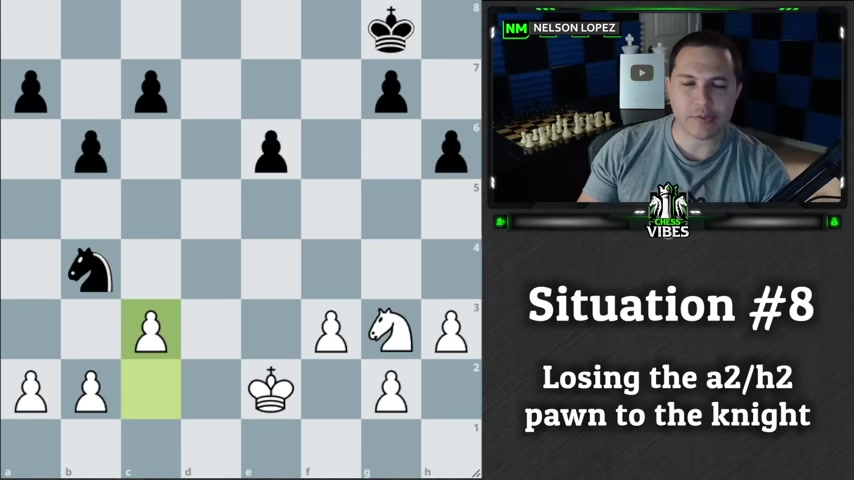
So it's important that we played both of these really work .
I like D two a little bit better .
But , uh , it's important that you keep that in mind , you gotta keep it trapped .
OK ?
And as long as you get the night you should be doing OK ?
All right .
So , speaking of Knights being trapped , here's another example for you .
So we're playing this game against Black and Black plays the move night to before .
And they're feeling pretty clever about themselves because they just fork their pads and they're thinking , hey , look at that , I'm gonna win a pond , right ?
What you can do when this kind of situation happens is you can play C three .
And why are we playing C three ?
Well , the reason is if black takes this , which by the way is a big mistake , we can again trap the night by playing king the D one and notice how the pawns are kind of stopping these two squares from the night .
And so then all you have to do is somehow stop this square with , with another one of your pieces .
A lot of times there's a rook back there or in this case , it's our king , right ?
And the night is just stuck the night .
Can't go anywhere so black can do whatever they want .
We're gonna come over with our king and guess what ?
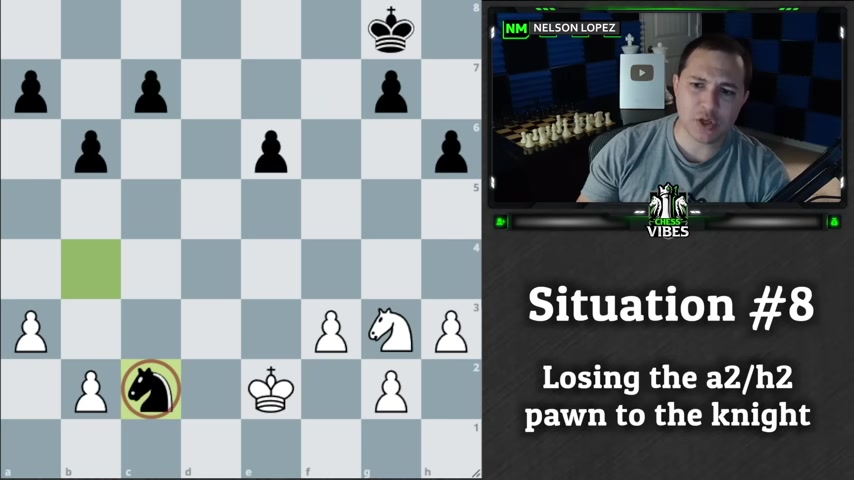
Once we get here that night is , is trapped , worst case or best case for Black , they have to give it up for here .
And the night is gone , we're probably gonna be able , uh , to win this end game now .
So , going back , sometimes you can just let the night take that pawn .
As long as you're able to play C three , there's a very good chance that that night is going to be trapped .
Ok ?
And you can see how it's different than if we play a three because now the night takes here and this is much more difficult to trap the night here because it has a lot of places , right ?
That it could potentially go to .
So you have to do it correctly and play C three and then you just go over there and , and get yourself a free night .
Ok ?
So keep that one in mind , right ?
And the next situation is actually very similar .
You can , you notice this position is almost the same , but I've swapped blacks knight for a bishop and let's just say that they take this pawn .
What do you think my recommendation is going to be for what we can do ?
That's right .
We're gonna play B three and we're gonna trap the bishop and learn it .
It can't go anywhere , it can go here .
But then our king just comes over and guess what ?
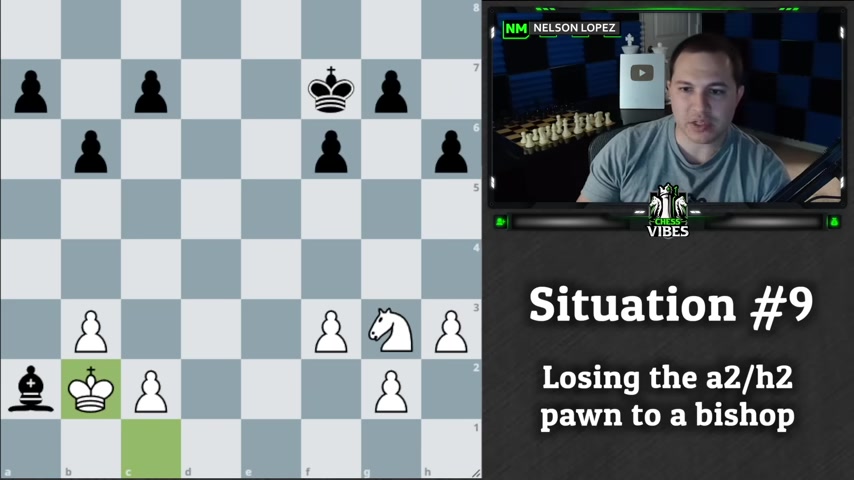
We're gonna trap it , right ?
And eventually we're gonna come here over here and just take it .
We just want a piece .
Ok ?
So , same idea .
Except , you know , the way that you trap it is .
Obviously different depending on if it's a knight or a bishop that takes your pawn .
But keep that in the back of your mind .
Now , a little bonus tip for you here , let's just say for the sake of example , here we're playing black , we capture the pawn and white plays B three on us .
And we're like , oh no , this is what Nelson said .
Now , my bishop is gone right wrong .
If this happens to you don't panic , what you wanted to do is immediately start pushing this pawn down .
And why do I say that ?
Because if we can get here right away and force White to capture us , guess what ?
Then our bishop is gonna be able to escape .
OK .
So for example , a five white's coming over to , to trap it , right ?
A four and notice now , well , first of all , if white takes us , we we're fine .
Our bishop can't survive .
So that's great .
Right ?
We saved our bishop .
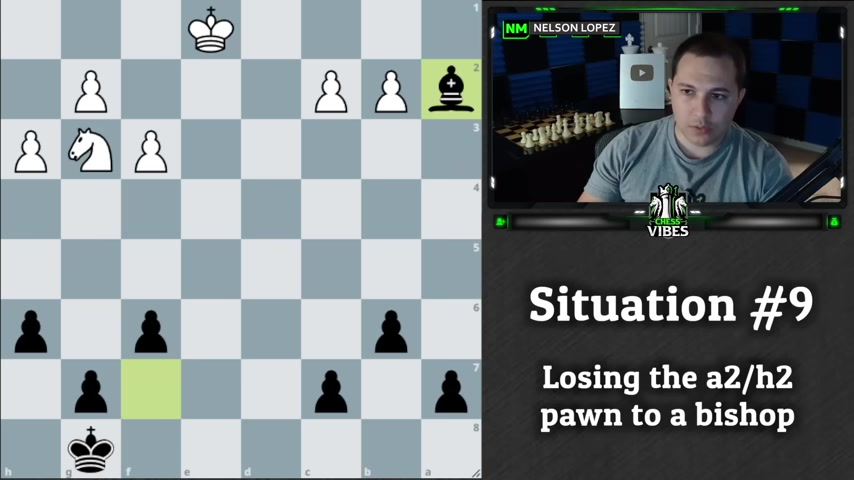
But if white , let's say he goes here to try to continue trapping us .
Well , now we can just take and if , if white does this , they lost too many ponds , right ?
We take here and we're about to get a queen and they can't , they don't have time to take our bishop .
They can take our pond .
But still our bishop is fine .
We actually got all of white's pawns in the process .
So if that happens to you remember , start pushing that pawn , OK ?
Now , depending on how , where the king is , you might not have time .
But in this example , you , you would have time because the king needs three moves to get over there and you have , you know , two moves and you're ready to go .
So , uh just , you know , some tips there regarding trapped bishops .
Definitely something you want to think through before you take the pawn , right ?
Like if , if White's king was sitting over here on C one .
Absolutely .
I would not take that because of course , I'm just gonna get trapped .
So those are the things you want to , you know , keep in mind .
Ok ?
So the last situation I have for you is this position right here .
It's white to play and they hit us with the stunning move .
Bishop takes F seven check .
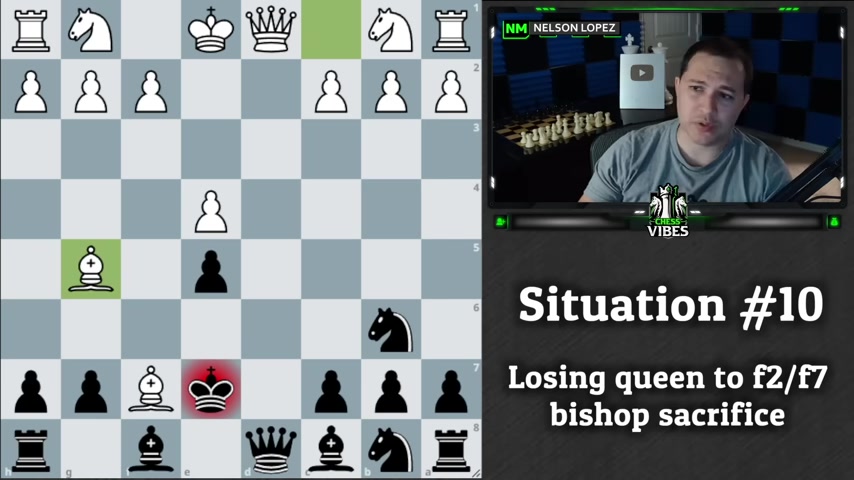
And as we sort of try to figure out what's going on , we notice that if we take the bishop , it lures our king away and then White's queen is gonna come down and take our queen for free .
And so we kind of have a moment of panic and we're like , well , let me try to go to E SEVEN to defend my queen .
And then White hits us with bishop G five and we're toast .
We are absolutely toast .
We lose the queen , we're losing the game .
Everything is just , that's it .
So , uh what do we do wrong ?
Well , there's a little trick here .
Ok ?
And first of all , this is a nice tactic to be aware of .
If you haven't seen this before , you sacrificed the bishop to lure the king away so that your queen can take .
So whenever you have tension between the queens and your bishop is lined up , keep that in mind .
But here's what I want you to remember if this happens to you .
OK ?
Takes , takes sometimes depending on the position .
But in this case , it works , You've got a rook lined up with the queen .
So if we can take advantage of that somehow and actually we can bishop to be for check , unleashes our rook and it's check with the bishop .
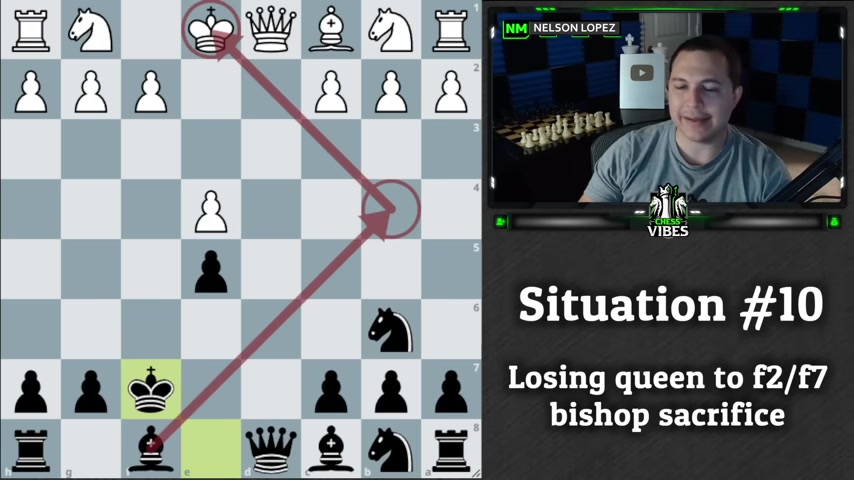
So if White just blocks our bishop , we take the queen , right ?
We get our queen back .
The only other thing they could do is block with the queen , but again , we still take it , we still get our queen back .
Yes , we lost the pond .
Yes , White's probably a little better here , but the game goes on , right .
You still have a fighting chance and it's not like immediately over when you lose your queen .
So keep that in mind a little discovered check idea there with the , the bishop and you know , to get the rook to come over to , to , to save your queen .
So , um yeah , that's uh what I have for you there .
All right guys .
Well , I hope you enjoyed those 10 different ways to kind of save the position even though it looks like it might be really bad .
A lot of times you do have tricks to get out of it .
I'll see you over here in this video where I present you with three positions and you have to choose which one is the winning position .
But as always stay sharp , play smart and take care .
Are you looking for a way to reach a wider audience and get more views on your videos?
Our innovative video to text transcribing service can help you do just that.
We provide accurate transcriptions of your videos along with visual content that will help you attract new viewers and keep them engaged. Plus, our data analytics and ad campaign tools can help you monetize your content and maximize your revenue.
Let's partner up and take your video content to the next level!
Contact us today to learn more.